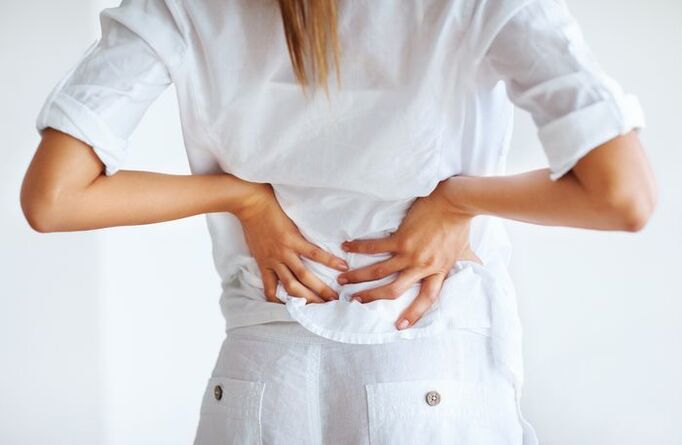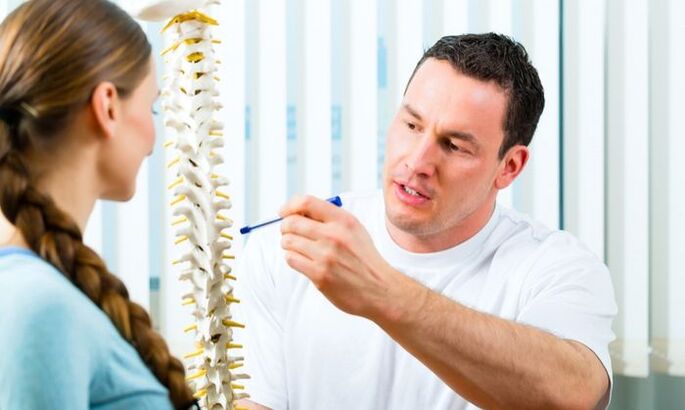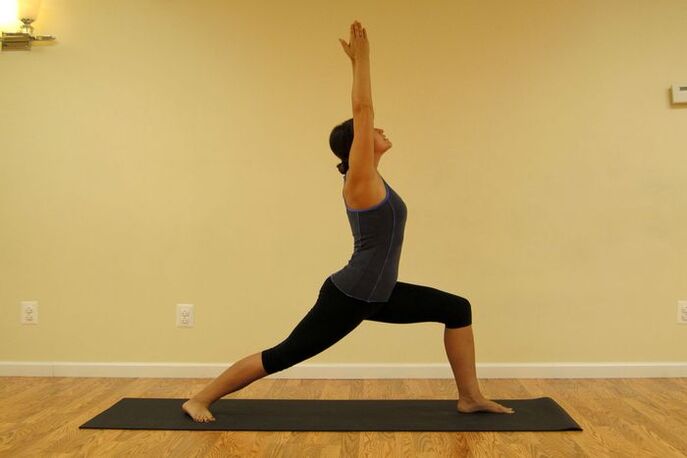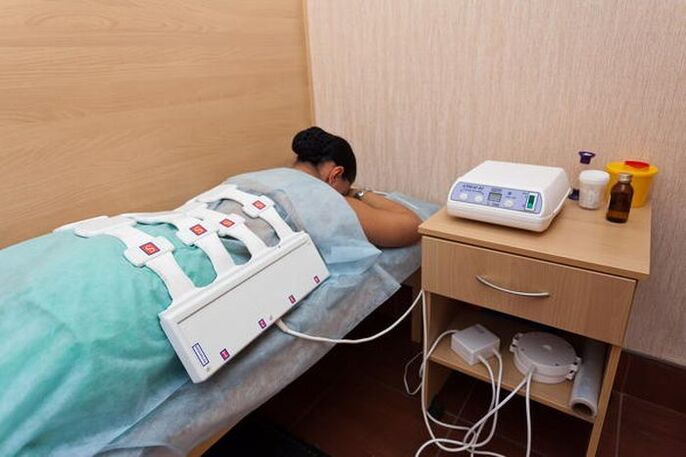
Connecting the fixed, thoracic and sacral parts of the spine, the lumbar plays the most important role. Provides mobility of the spine.
With the development of degenerative processes in the intervertebral discs, signs of osteochondrosis of the lumbar spine appear. Serious illness can significantly complicate existence, leading to reduced work ability and even disability.
Causes
This disease is becoming more widespread all over the world. This is facilitated by common factors such as physical inactivity, poor environmental conditions, malnutrition and obesity. At the same time, the greatest loads often fall on the back, so it is important to know the causes of lumbar osteochondrosis.
- More than half of the cases of the disease are associated with a hereditary predisposition, which determines the structure of the intervertebral discs, which are easily deformed.
- Work associated with regular physical overload is a negative factor that can cause spine problems.
- With improper posture, exacerbated by hypodynamics, the lumbar region is subjected to greater stress.
- Spinal injuries in the future often lead to the manifestation of the disease. Therefore, representatives of professional sports are in danger.
- Many years ago, osteochondrosis was a disease of the elderly - it has its own logic. Disks are more prone to deformation over the years. However, today this disease can be noticed in 30-year-olds. The impetus for the development of osteochondrosis are mistakes in performing complex physical exercises on their own.
- If there are any pathologies of the joints, then strong hypothermia and sharp tension when lifting a heavy load can cause pain.
- Excess weight additionally burdens all joints of the spine.
- Often, the onset of the disease is associated with pathologies of some internal organs: liver, kidneys and others.

Symptoms
So, consider the signs of lumbar spine osteochondrosis.
- The first and main symptom of the disease is pain, initially periodic, which occurs in the lumbar region during heavy exertion. It initially passes after rest, but then becomes permanent, covering not only the lower back but also the lower body. During further destruction of the vertebrae, the pain becomes stronger, there is a feeling of heat or cold in the back.
- Sensitivity of the skin of the lower part of the body is reduced or even completely disappears, arteries may constrict. The fact that the spine is no longer fixed by the disc is fraught with serious damage to internal organs.
- The symptoms of lumbar osteochondrosis in women are complemented by inflammation in the ovaries, appendages and uterus. This circumstance can mask the main signs and lead to a misdiagnosis.
- Due to severe pain, the person must be in an unnatural position most of the time, due to which the spine is moved to one side. There is bending in the posture, and tension in the gait.
- The spine loses its mobility and flexibility. The effect of lumbodia is observed when it is difficult for the patient to stand up after a long work in a bent state.
- Compression of the nerve root in the spine is accompanied by acute pain and may have consequences in the form of reduced mobility.
- Osteochondrosis of the lumbar spine is also characterized by symptoms of ischemic syndrome, a group of signs associated with decreased blood flow in compressed blood vessels. In the beginning, spasm of the arteries occurs sporadically, followed by pain when walking. After a break they pass. However, over time, the cramp becomes prolonged, the pelvic organs stop receiving nutrition, which interferes with their work. Stopping blood flow can lead to paralysis.
- The disease can cause back pain. The signs of sacral osteochondrosis differ in a certain originality, so they are more difficult to diagnose. Despite the strong, even shooting pains, they are given to the surrounding tissues, so that the patient cannot specify the exact location of their localization. In addition, they are accompanied by inflammatory processes of the genitourinary system. Frequent urination or urinary incontinence occurs, constipation, the patient finds it difficult to sit and move.

Complications
If the problem is not treated, then progressive disease can lead to serious complications.
- The result of the rupture of the fibrous ring will be pinching of the nerve endings with protruding nucleus pulposus - an intervertebral hernia will appear.
- Prolonged inflammatory processes in the spine can result in sciatica - a disease of the roots of the spinal nerves.
- A very serious complication is inflammation of the sciatic nerve, which is characterized not only by severe pain, but also numbness of the limbs.
- Impaired blood flow to the spinal cord can cause compressive myelopathy.
- Horsetail syndrome is one of the most serious consequences of osteochondrosis. The bundle of nerve endings that extends from the vertebrae at the end of the spinal cord is responsible for transmitting impulses from the body, enabling the brain to control the work of the body. Their acute inflammation can cause dysfunction of the genitourinary system and partial or complete paralysis of the limbs.
Treatment
Osteochondrosis of the lumbar spine, its symptoms and treatment depend on the place where the nerve ending is tightened, where pain and loss of sensitivity are felt. If therapy is started on time, then it will be quite successful, but, in any case, it will require an integrated approach.
Medications are used only to relieve acute pain. The main goal of therapy is to stop the development of the disease and return the spine to the correct position, restoring normal blood flow in it. This is a complex and time-consuming process that requires the use of various rehabilitation methods.

Physiotherapy
Therapeutic gymnastics occupies a significant place in rehabilitation. It is prescribed a few days after the elimination of severe pain, is selected specifically for each patient and depends on:
- stage of the disease,
- causes of lumbar osteochondrosis,
- patient's age,
- places of pain localization,
- and other factors.
The main goal of therapeutic exercises is to create a reliable muscular corset that will help reduce the load on the intervertebral discs. In the initial period, several exercises with a small load are offered. It is gradually increasing. Over time, special exercises are added to the general exercises.
Gymnastics is first performed lying on your back. In this case, the load on the spine is minimal, there is no increase in pain. The next stage is exercise, lying on your side and then on your stomach. You can put a pillow under it, and a roller under the joints of the lower extremities.
In the initial phase, all exercises are performed very slowly and carefully. Gradually, as the amplitude of the movement increases, new ones are added. After the pain stops and the patient's condition improves, the complex is supplemented with exercises that are performed standing on all fours, then sitting on a chair, then standing.
If the disease is in a chronic form, then, depending on the patient's well-being, he is allowed to engage in certain sports - swimming, skiing and others. The effectiveness of therapeutic exercises will increase many times over with regular classes.

Manual therapy and massage
Manual therapy is one of the oldest and most effective methods within the complex measures for the treatment of lumbar osteochondrosis and its symptoms. The course includes several procedures that can eliminate the cause of pain and numbness in the limbs, relieve tension in muscle fibers, restore blood circulation and joint mobility. Using this technique, you can get a quick and positive effect, comparable to the results of therapeutic exercises. However, there are some contraindications that should be considered when engaging in complex treatment.
An excellent tool in the fight against serious diseases is massage. After a few sessions, the patient feels better, muscle stiffness disappears and joint mobility returns. But each case of the disease has its own characteristics and only a qualified specialist should prescribe this procedure.
There are a number of contraindications, in the presence of which massage is prohibited for a certain category of patients:
- neoplasms of various natures;
- third degree hypertension;
- youth in the field of massage;
- arrhythmia and other heart pathologies;
- blood diseases;
- gynecological diseases and some others.
A traditional type of massage is usually prescribed. The first procedures may be accompanied by mild pain, which will soon stop.
Severe pain during the session is unacceptable. Canned vacuum massage can be used to improve blood flow to the affected area.
Your doctor will help you beat lumbar osteochondrosis and symptoms and choose the most effective treatment. Most likely, massage will be included in the list of recommendations.
Physiotherapy
The complex of therapeutic measures includes physiotherapeutic methods. They allow you to act locally on the affected area and eliminate unpleasant symptoms. The following types of physiotherapy are widely used:
- exposure to an electric or electromagnetic field allows you to increase blood flow and metabolic processes in tissues;
- ultraviolet light relieves inflammation, stimulates the production of vitamin D, strengthens the body's defenses;
- ultrasonic waves have a high anti-inflammatory effect;
- Balneotherapy has a wide application both in the treatment and in the prevention of spinal diseases, due to the mild and effective healing effect of mineral springs and therapeutic mud.
This method also has certain contraindications, which should be taken into account when prescribing such procedures.
There are many folk recipes that are widely used for osteochondrosis of the lumbar spine, as they have proven to be effective drugs. They can be a good addition to the main treatment after consulting a specialist. Ointments and dressings, herbal decoctions can be used for rubbing or swallowing. Self-made products can cause allergic reactions. Poisonous plants can also be prescribed in prescriptions, so it is necessary to monitor the exact dose of such substances, check the reaction of the organism to their use and consult a doctor.

Prevention
Measures that can prevent this serious disease should be comprehensive and include, above all, physical activity. These can be long walks at a leisurely pace, regular trips to the pool, sports. Walking and running help engage major muscle groups, and water helps them relax better and increase range of motion.
Of great importance for health is a balanced fractional diet, in which significant attention should be paid to foods high in fiber. Vegetables and fruits will restore the normal functioning of the digestive system, metabolic products will not stay in the intestines, poisoning the body. Thanks to the small portions, the food will be completely processed.
It is necessary to organize a good rest and proper sleep on a flat and hard surface. Useful orthopedic mattresses that maintain the natural position of the spine.
The first signs of lumbar osteochondrosis require urgent medical attention, and then there is the possibility of successful treatment and restoration of spinal function.



















